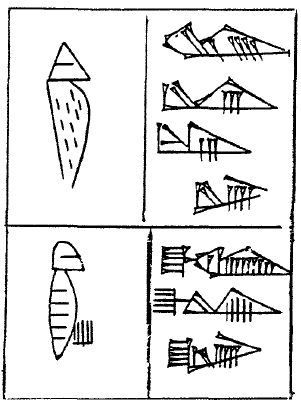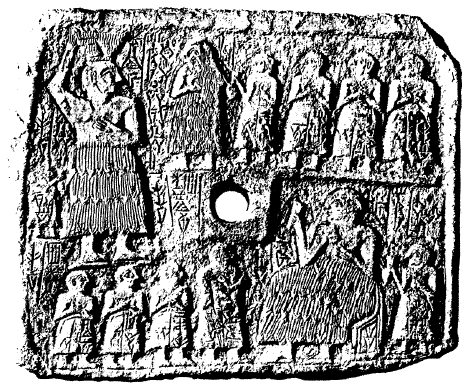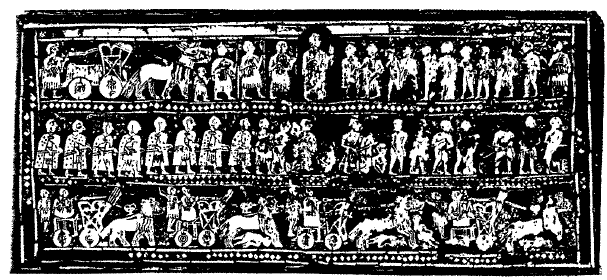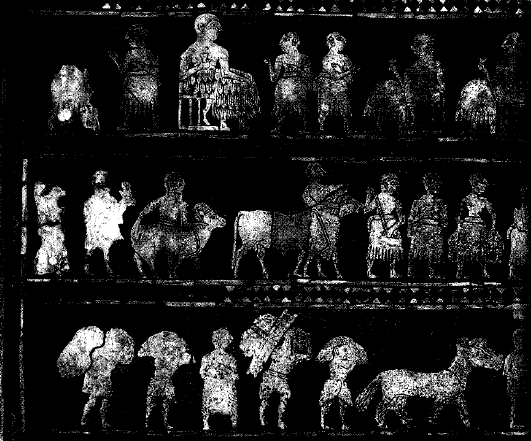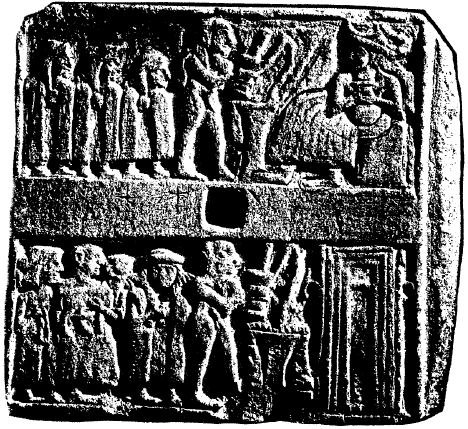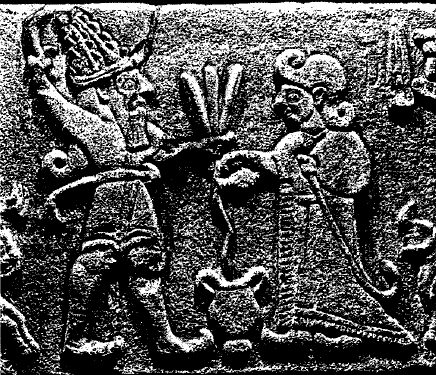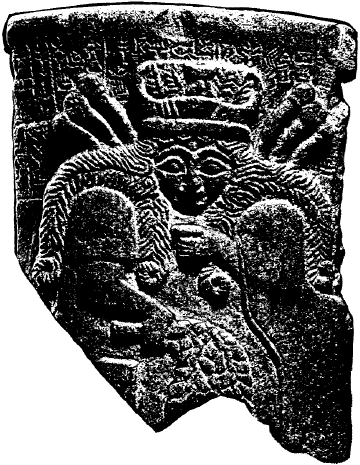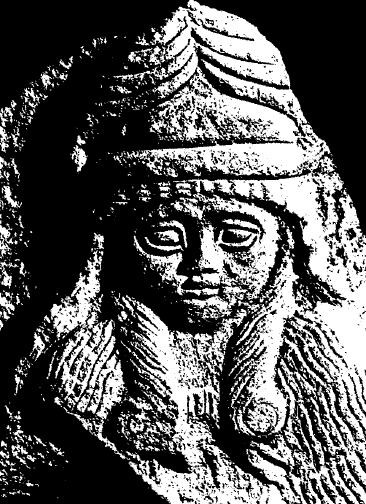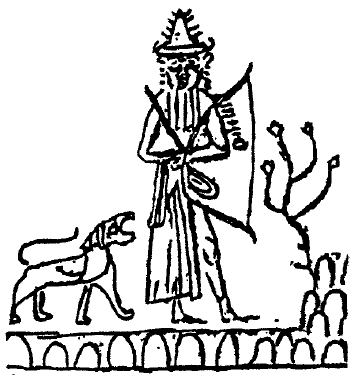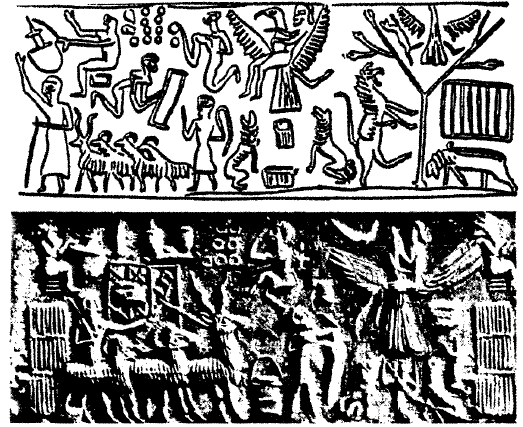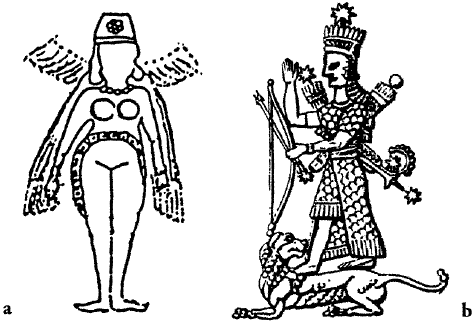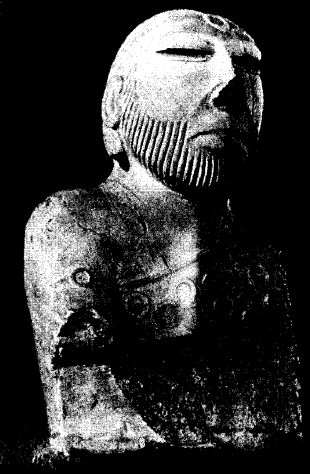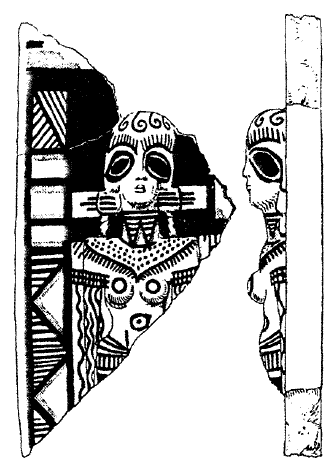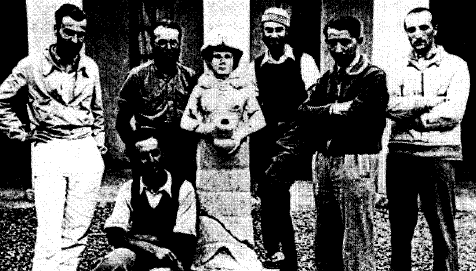|
In retrospect, I realized that the teacher did not invent the ‘giants’ interpretation, and that there had to be a reason why the scholars assigned by King James I of England to translate the Hebrew Bible used the term ‘giants’: They relied on earlier translations of the Hebrew Bible - in Latin known as the Vulgate, dating back to the 4th and 6th centuries A.D. and a prior Greek translation (the Septuagint) done in Alexandria, Egypt, in the 3rd century B.C.
And in both those early translations, the word Nefilim is rendered "gigantes."
Why?
Selecting twelve men, one from each tribe, Moses told them:
Proceeding as instructed, the twelve scouts,
And when the scouts returned, they said to Moses:
The singular Anak is also rendered in the plural, Anakim, in Deuterenomy 1:28 and 9:2, when Moses encouraged the Israelites not to lose heart because of those fearsome "descendants of Anak"; and again in Joshua 11 and 14, in which the capture of Hebron, the stronghold of the "Children of the Anakim," was recorded.
Capturing their fortified strongholds, with particular attention to Hebron, was a special achievement in the Israelite advance. When the fighting was over, the Bible states,
The uncaptured strongholds were all cities of a Philistine coastal enclave; and therein lie additional reasons for equating the Anakim with giants - for King David’s giantlike Philistine adversary Golyat (‘Goliath’ in English) and his brothers were descendants of the Anakim who remained in the Philistine city of Gath.
According to the Bible, Goliath was more than nine feet tall; his name became a synonym for ‘giant’ in Hebrew.
Describing the capture of Hebron as the feat that brought the fighting in Canaan to an end, the Bible had this to say about the city (per the King James translation):
More modern English translations of this statement offer some variations regarding the identity of Arba.
The New English Bible renders it,
The New American Bible translates,
And the new Tanach Jewish Bible says,
The translation problem stems from the fact that the Hebrew text describes Arba as "the Ish Gadol of the Anakim. "
Literally translated, Ish unambiguously means a male Man; but Gadol could mean both ‘Big/Large’ as well as ‘Great’. So, was the intention of this descriptive epithet to say that Arba was a Big Man in size - a ‘Goliath’ - or a Great Man - an outstanding leader?
We don’t have a picture of Arba (whose name literally meant ‘He who is Four’); but we do have ancient depictions of Sumerian kings; and in the Early Dynastic period they were depicted as big fellows (for example, Fig. 74).
Figure 73
Figure 75
Figure 76
Though not a king, the demigod Adapa - son of Enki - was described as big and robust. If such ‘Big Man’ demigods inherited that genetic trait from their divine parents, one would expect depictions of gods and men to also show the deities as relatively giantlike; and that was actually the case.
Figure 77
Similar depictions have been found in Elam; and the same ‘ratio’ of king-to- deity is also seen in a depiction of a big Hittite king offering a libation to an even bigger god Teshub (Fig. 78).
Another perspective of this theme can be seen in Fig. 51, in which a lesser deity introduces a king to a seated god who - were he to stand up - would be at least one-third taller than the others.
Figure 78
More famous for her size, even in her younger
days,
was the goddess Ba’u (Fig. 80), the spouse of the god Ninurta; her
epithet was Gula (= ‘The Big One’).
Figure 79
Figure 80
Luckily, the great archaeological discoveries of the past two centuries enable us to identify them and to bring them to life - even as they died.
It was only then, when Moses recounted who had inhabited Canaan, that the Bible mentions the Anakim and a sub-group called Repha’im (a term that might mean ‘Healers’) who per Deuteronomy 2:11 "as Anakim are considered." Most (except for certain ‘Children of Anak’) were replaced by a variety of tribe-nations who repopulated those lands after the Deluge.
And in that long and comprehensive list, only one sole heroic figure called Nimrod is named.
We mentioned earlier the scholarly assumption, upon the discovery and decipherment of the cuneiform tablets, that ‘Nimrod’ (whose domains included Erech in the land of Shine’ar) was the famed Sumerian Gilgamesh, king of Erech/Uruk - an incorrect assumption, as it turned out.
But the Hebrew epithets applied to Nimrod - a Gibbor, a Hero, a Mighty hunter - unmistakably links him to the plural Gibborim of Genesis 6:4, and thus identifies him as one of the continued line of demigods.
(In Sumerian iconography, it was Enlil
who was depicted as the granter of a hunting bow to Mankind, Fig.
81).
Figure 81
The assertion that Nimrod was "brought forth" in Kish can serve as an invaluable clue regarding his identity; it lurks, I believe, unrecognized among the demigods associated with the god Ninurta.
It certainly links these biblical verses to the Sumerian King List, where it is stated in regard to the post-Diluvial period:
Kish was not one of the pre-Diluvial cities that were rebuilt exactly where they had been once Mesopotamia was habitable again; it was a new city, intended as a neutral capital, whose establishment followed the creation of separate regions for the contending Anunnaki clans.
But as nature would have it, the calamity that destroyed one side of the Earth had beneficial effects on the other side:
As a result, the gold that Nibiru needed could be obtained there without the toil of mining.
Preempting Enki, Enlil sent his son Ishkur/Adad to take charge of the golden territory. Control of the repopulated olden lands thus became a pressing issue for the ‘deprived’ Enki’s clan; the suggested creation of distinct regions and clearly delineated territories was an attempt at peacemaking by Ninmah.
The allocation of three regions matched the three biblical nation-state branches emanating from the three sons of Noah; its purpose and result was to allot,
The principal aim of forming the regions - a ‘share and share alike’ arrangement between and within the Anunnaki clans - was not readily attained.
Discord and strife soon broke out among the Enki’ites; Egyptian lore recalled it as first the struggle for dominion between Seth and Osiris, leading to the killing of Osiris, then in revenge warfare between Horus (born of the semen of Osiris) and Seth.
Enki’s son Marduk (Ra in Egypt) repeatedly tried to establish himself in Enlilite territories.
A relatively peaceful era - negotiated by Ninmah - was again shattered by a rivalry between Enki’s sons Ra/Marduk and Thoth/Ningishzidda. It took another millennium to restore Earth and Mankind to stability and prosperity, making possible Anu’s state visit to Earth, circa 4000 B.C.
Peleg was born, according to the Bible, 110 years after the Deluge; using the ‘times sixty’ formula, it would date the birth of Peleg to circa 4300 B.C. (10,900-6,600) and the "division" to circa 4000 B.C.
That calendar, begun in 3760 B.C., is still followed as the Jewish Calendar to this day.
It was intended as a national capital, a kind of ‘Washington D.C.’; and it was there that the Anunnaki started the line of post- Diluvial kings by,
* * *
But the Sumerian King List actually named the first ruler in Kish; regrettably we still don’t know it, because the inscription is damaged right there, leaving legible only the syllables Ga. - . - .ur. What is clearly legible is the statement that he reigned for 1,200 years!
Since these are numbers clearly divisible by 6 or 60, the unanswered question is whether these are factual reign lengths, or did the ancient copying scribes misread them, and it should have been 200 (or 20) for Ga. - . - .ur, 15 instead of 900 for the next one, etc.
Which was it?
So would be the 1,560 years attributed to the 13th king in Kish, Etana, regarding whom the King List makes the long notation:
In this case, the royal
notation is supported by discovered literature, including an ancient
two-tablet text relating The Etana Legend, for he was indeed a king who "to heaven ascended." A benevolent ruler, Etana was despondent by the lack of a male heir, caused by his wife’s pregnancy difficulties that could be cured only by the heavenly Plant of Birth.
So he appealed to his patron god Utu/ Shamash to help him obtain it. Shamash directed him to an "eagle’s pit"; and after overcoming varied difficulties the Eagle took Etana aloft to the "Gate of Anu’s heaven."
Rising a second beru (a measure of distance as well as degrees of the celestial arc), the Eagle again urged Etana to look down:
According to one version of the tale, Etana and the Eagle "passed through the gate of Anu."
According to another version, Etana became alarmed and cried out to the Eagle:
Frightened, he shouted to the Eagle:
Heeding the cries of Etana, who was "laying slumped on the Eagle’s wings," the Eagle fell back to Earth; but (according to this version), Etana and the Eagle made a second attempt.
It was apparently successful, for the next king in Kish, Balih, is identified as "son of Etana." He reigned a mere 400 (or 410) years.
Figure 82
The tale is instructive in several respects: It describes realistically a flight out to space with a diminishing Earth in sight; it also corroborates what many other texts suggest - that comings and goings between Earth and Nibiru were more frequent than once in 3,600 years.
The tale does leave Etana’s mortal vs. demigod status unstated; but one can only surmise that Etana would not have been allowed the space flights, nor would have reigned a purported millennium and a half, were he not a demigod.
There followed kings reigning 900 and 1,200 years; and then En.me.bara.ge.si,
Though the Shar counts are gone, the two theophoric names sound familiar; they place these post-Diluvial kings in the same names category as the pre-Diluvial ones (of the WB tablets and the Berossus list) who had gods as parents.
They also provide a historical dimension to the Kish list, for the name Enmenbaragesi was found inscribed on an archaeological artifact - a stone vase now in the Iraq Museum in Baghdad; Elam (whose weapons he took as spoils) was an historically verified kingdom.
And then Kingship in Sumer was transferred to Uruk.
Though obviously a demigod, fathered by the god Utu/Shamash, no more than 324 years (also a number, please note, divisible by 6) are assigned to him; and no explanation is offered for such a short reign by a full-fledged demigod.
His name conveyed the meaning ‘Handy, dexterous’. And since no other text about Meskiaggasher has been found, we can only guess that the sea he crossed to reach a mountainland - a voyage that merited its quoted mention - were the Persian Gulf ("Lower Sea") and the land Elam, respectively.
Ambitious and enterprising - the Great God List records more than one hundred epithets for her! - Inanna, outsmarting the womanizing Enki, managed to obtain from him more than a hundred Me (‘Divine Formulas’) needed to make Uruk a principal city.
Archaeological evidence suggests that it was he who built the city’s first protective walls, and expanded the E.Anna temple into a sacred precinct worthy of a great goddess, the goddess Inanna.
An exquisitely carved alabaster vase from Uruk - one of the most prized objects in the Iraq Museum an Baghdad - depicted a procession of worshippers, led by a giantlike naked king, bringing offerings to the the ‘Mistress of Uruk’.
Much more is known of him, for he was the subject of several epic tales, the longest and most historical of which is known as the tale of Enmerkar And The Lord of Aratta - one of whose revelations, most dearly and repeatedly stated, is that Enmerkar’s realfather was the god Utu/Shamash. This made him a direct relative, and not just a worshipper, of Utu’s sister Inanna; and therein one finds an explanation for enigmatic journeys to a distant kingdom.
Another idea was to enhance peace through intermarriage; and chosen for the purpose was Enlil’s granddaughter Inanna/Ishtar and the shepherd god Dumuzi - Enki’s youngest son (but only a half-brother of Marduk). References in varied texts suggest that the unassigned Third Region, the Indus River valley, was intended as a dowry for the young couple. (The Fourth Region, from which Mankind was excluded, was the Spaceport in the Sinai Peninsula.)
As it happened, the young Inanna and Dumuzi not only liked each other, but fell in love. Engaged to be married, their torrid love and lovemaking is described in long and detailed poems, mostly composed by Inanna, giving her a reputation as Goddess of Love (Fig. 83a).
The poems also revealed Inanna’s ambition to become, through the marriage, Mistress of Egypt, and this alarmed Enki’s son Marduk/Ra; his efforts to disrupt the marriage led - unintentionally, he claimed - to the death by drowning of Dumuzi.
Figure 83
Dubbed by us ‘The Pyramid Wars’ in The Wars of Gods and Men, they lasted several years and ended only with the imprisonment and then exile of Marduk.
The great gods tried to console Inanna by granting her sole dominion of the faraway Kingdom of Aratta, situated farther east of Elam/Iran and beyond seven mountain ranges.
Thus, it was the destination of the Meskiaggasher voyage and the locale of the significant events that followed.
(An instance of such artificial insemination is recorded in Egyptian tales of the gods, when the god Thoth extracted semen from the phallus of the dead and dismembered Osiris and impregnated with it Isis, the wife of Osiris, who then gave birth to the god Horus.)
When Aratta, described in the text as "a highland place of silver and lapis lazuli," delivered the tribute, Enmerkar’s heart grew haughty and he sent his ambassador to Aratta with a new demand:
Undeterred, Enmerkar sought the help of Nidaba, goddess of writing, in inscribing on a clay tablet a written message to Aratta in a language its king would understand, and sent it with another special emissary (the text suggests here that this emissary flew over to Aratta: "The herald flapped his wings," and in no time crossed the mountains and reached Aratta).
Sometimes she piloted herself, dressed as a pilot (Fig. 85), sometimes her aircraft was piloted by her personal pilot, Nungal. But prolonged droughts that devastated the grain-based economy of Aratta, and the centrality of Sumer, made Uruk the ultimate winner.
The King List states laconically,
But considerably more information is provided about him in such texts as Lugalbanda and Enmerkar, Lugalbanda and Mount Hurum, and Lugalbanda in the Mountain Darkness - texts that describe different heroic episodes that could have been segments of an encompassing text - an Epic of Lugalbanda, on the pattern of the Epic of Gilgamesh.
As they arrive at Mount Hurum on their way, Lugalbanda falls sick. His companions’ efforts to help him fail, and they leave him to die, planning to pick up his body on their return.
But the gods of Uruk, led by Inanna, hear Lugalbanda’s prayers; using "stones that emit light" and "stones that make strong," Inanna restores his vitality and he does not die. He wanders off alone in the wilderness, fighting off howling wild animals, pythons, and scorpions. Finally (presumably, for the tablet is damaged here) he makes his way back to Uruk.
Sent alone on a hush- hush mission with a secret message that he had to memorize, his way is blocked at a vital mountain pass by the "Anzu Mushena monster bird whose "teeth are like those of a sharkfish and its claws like a lion’s" and who can hunt down and carry a bull.
Consistently defined in the text by the determinative mushen, which means ‘Bird’, the "Anzu Bird" claims that Enlil placed him there as Gatekeeper, and he challenges Lugalbanda to verify his identity:
Bemused, perhaps, by the use of a pre-Diluvial term, Lu.lu, for ‘Man’, Lugalbanda answered with his own play of words.
Referring to the sacred precinct of Uruk, he said:
The god Shara is mentioned in various texts as a son of Inanna, though never with any indication of who his father was.
One guess has been that he was conceived during Anu’s visit to Earth; the Tale of Zu identifies Shara as "the firstborn of Ishtar" - admitting the existence of unnamed others.
There is no mention that Inanna’s love sessions with Dumuzi produced a child, and it is known that after the death of Dumuzi, Inanna introduced the rite of a "Sacred Marriage" in which a male of her choosing (as often as not the king) would spend a ‘betrothal night’ with her on the anniversary of Dumuzi’s death; but no offspring of record has been listed as a result.
That leaves unknown the identity of Lugalbanda’s father, though the inclusion of the term lugal as part of his name suggests a royal lineage.
Missing the great size of other demigods, he seems to have been more like his mother in this respect:
Figure 86
His name, with the Dingir determinative, concludes the Inanna listings on Tablet IV in the Great God List and is granted the honor of starting Tablet V, followed by dNinsun dam bi sal - ‘divine Ninsun, female, his spouse’ - and by the names of their children and varied court attendants.
It was so when the people,
But then they started to,
It was to stop such ambitions on the part of Mankind that Yahweh, having "come down to see the city and the Tower," got concerned and said:
It was the building of the Tower of Babel’ that made Yahweh "confuse Mankind’s language," and "scatter them from there over the face of the whole Earth."
The Greek historian Alexander Polyhistor, quoting Berossus and other sources, also tells that before building a large and lofty tower, Mankind "was of one language."
Indeed, it might explain why the earliest terms and names in Egyptian sound like Hebrew:
The Bible then states that the Confusion of Languages was a deliberate divine act. Imagine finding corroboration for that in the Enmerkar texts!
According to the Enmerkar epics, Enki did it...
|
